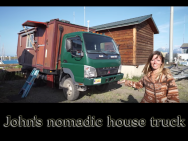
Drivin’ on up!
Eunice and I went on our very first weekend road trip last week! We went up to visit my Godfather, David who I reconnected with via the power of Facebook. I haven’t seen him since I was a very young child. He and his brother moved out to the west coast to pursue a career in bodybuilding. David has been back in the east coast for an artistic endeavor that’s nearing completion.
As a child, I would occasionally see him in magazines or on television and be so proud to be connected to him in some way even though he was never in my life the way Godfathers were supposed to be. He was a free-spirited young man living out his dream in L.A. and wasn’t very concerned at that point with fulfilling such a role for a little girl. It was a great disappointment growing up.
I’m no longer eight years old and since then, had suffered much deeper blows at the hands of family, thus making it easier to put past hurts behind me and reach out to him. After all, I was still so very intrigued and curious about this distant, mysterious figure that lingered in the background of my life.
I was nervous (something that rarely happens to me anymore), but when I finally saw him, he gave me a warm hug and that feeling quickly went away. David is definitely what someone would describe as “a character”… charismatic, light-hearted and somewhat eccentric. People around Providence call him “The Cowboy” because in a sea of conservatively dressed New Englanders, he stands out where ever he goes.
We took his Great Dane out for a long walk and had a good talk about his photography, my plans to venture west, and about the mechanics of life. He opened his home to me, made me awesome vegan dishes, baked for me, took me out to dinner, took me to the movies… and even made me the subject of an impromptu photo shoot! David spoiled me rotten the entire weekend. It was the first time in a very long time that I felt like the center of someone’s attention… almost like a kid! It was very well needed.
David and his dog Cowboy
After my weekender, I couldn’t help but feel that some sort of karma had been released from this experience, as I felt so much “lighter and brighter”. It was a rewarding first trip in which a connection was reestablished. It makes me wonder what other connections will be made in the time to come…
Side note: David may seem familiar to many of you (especially those of you who came of age during the 80’s & 90’s). That’s because he’s one half of The Barbarian Brothers!…
¿QUIERES UNA CASA DE PRIMAVERA PERO NO TIENES PRIMAVERA? DESVIAR EL AGUA DE UN ARROYO PEQUEÑO ES UNA OPCIÓN
En la Parte I , cubrí el enlatado y el ahumado como métodos de conservación de alimentos. Este artículo echa un vistazo a la refrigeración y la deshidratación.
La congelación y la refrigeración son la forma más fácil de conservar alimentos en comparación con otros métodos. El único problema es que, una vez congelado o enfriado, debe permanecer así hasta el momento del consumo.
Ante las maravillas de la electricidad y la tecnología moderna, ¿cómo hizo la gente esto?
En las granjas y en las aldeas pequeñas era común tener una casa de primavera que proporcionara refrigeración natural. Un edificio de piedra con canales cavados en el suelo sobre el que se levantaba la casa se construiría sobre un manantial natural. El agua del manantial fluiría a través de los comederos y las jarras de leche u otros productos podrían colocarse en los canales. Estos se mantendrían fríos a medida que el agua fluyera a su alrededor. Las repisas y los ganchos también se proporcionarían en la casa de primavera, para colgar la carne y las verduras en un ambiente más fresco.
Si la casa no se construyó sobre un manantial natural, el agua podría ser redireccionada desde un arroyo cercano. Inicialmente, algunas casas de primavera estaban hechas de madera, sin embargo, esto era propenso a la putrefacción. Por lo tanto, Stone es el mejor material, no solo resguarda mejor el frío, sino que no se descompondrá ni decaerá con el tiempo.
¿Te apetece construir tu propia casa de primavera? Puede encontrar más información en Bright Hub .
Otra opción que se usaba antes de la electricidad y todavía se usa en la actualidad es la de las bodegas de raíz.
Estas habitaciones subterráneas se mantienen frescas en verano pero por encima del punto de congelación en invierno, perfectas para frutas, verduras y productos enlatados. Las temperaturas frías evitan el crecimiento bacteriano y la humedad evita el marchitamiento. Idealmente, la bodega tendrá temperaturas entre 30 y 40 grados Fahrenheit, tendrá bajos niveles de luz solar, un buen aislamiento de materiales como paja o tierra y será fácilmente accesible.
Las bodegas de raíz vienen en una variedad de formas, desde las salas de paseo hasta la colocación de botes de basura en el suelo para crear una “mini” bodega. Si tiene un presupuesto ajustado, eche un vistazo a este video de Walden Effect, que hizo un sótano de un refrigerador viejo.
Hablando de refrigeradores, si quiere estar un poco más centrado en la tecnología, entonces hay varias opciones para el almacenamiento de alimentos fríos fuera de la red.
LOS PROPIETARIOS DE CASAS RODANTES HAN CONFIADO EN LOS REFRIGERADORES DE PROPANO DURANTE MUCHOS AÑOS, PERO ¿VALEN LA PENA EL COSTO?
Las neveras de propano han sido un elemento básico para muchos propietarios de …
El mes pasado describí el curso de Permacultura disponible en la Escuela de Vida Integrada (SOIL en inglés) en la ecoaldea Earthaven.
Recientemente, este programa ha sido certificado por Gaia Education, un proveedor de educación sobre sostenibilidad en todo el mundo. La credencial de Ecovillage Design Education (EDE) se proporcionará a través del programa de inmersión en Permacultura que se desarrollará entre el 10 de junio y el 11 de agosto de 2017 en la ecoaldea de Earthaven en Carolina del Norte. El programa proporciona a los estudiantes los conocimientos y las habilidades prácticas necesarias para diseñar una sociedad que alcance principios de desarrollo sostenible respaldados por el Programa de Acción Mundial de la UNESCO sobre Educación para el Desarrollo Sostenible .
El programa tiene cuatro dimensiones principales que están cubiertas. El elemento social implica trabajar hacia una visión común, mejorar las habilidades de comunicación y la capacidad de lidiar con el conflicto y la diversidad dentro de una sociedad. El elemento económico incluye evaluar el impacto de la economía global en los proyectos locales y proponer oportunidades económicas éticas dentro de los proyectos. El aspecto ecológico es aprender sobre los principios de permacultura, así como diseñar sistemas de agua para proyectos y aprender a aplicar principios de construcción ecológica. Finalmente, el aspecto de la cosmovisión se trata de mantener un estilo de vida saludable mientras se incorpora la práctica espiritual regular.
El cofundador de SOIL, Lee Walker Warren, dijo: “El programa ayuda a las personas apasionadas a comprender su impacto en la sociedad y forjar conexiones reales con ellos mismos y con los demás. Las personas que están profundamente comprometidas con sus comunidades locales y globales tienen el mayor impacto, tanto en otras personas como en el planeta “.
Más de 4,900 estudiantes han participado en el programa de Educación de Diseño de Ecoaldeas en todo el mundo, con el apoyo de Gaia. Existen varios lugares donde se llevan a cabo estos programas, entre ellos Estonia, Italia, Canadá, Chile, Corea del Sur, Tailandia, India, Escocia, Suiza, Japón y los Países Bajos. Sin embargo, SOIL es solo una de las dos organizaciones en los EE. UU. Que ofrecen el curso EDE reconocido por la UNESCO.
Al finalizar el curso en Earthaven, se otorgarán tanto un certificado EDE como un certificado de Diseño de Permacultura.
Actualmente, hay un descuento de $ 100 al reservar a través del sitio web de SOIL para el programa de Inmersión en Permacultura mediante el uso del código promocional: SOILPEI100.
Éste artículo es una traducción directa del original https://off-grid.net/unesco-credits-soil-course/…

Solar panel suppliers in South Africa are predicting an “avalanche” going semi-off-grid or off-grid in response to new regulations that increase the costs of operating solar panels while attached to the grid.
According to the new regulations, 78-year-old Andrew Louwrens has an illegal solar electricity installation in his garden – despite having used solar panels since 2012.
Andrew, a retired SA Rugby administrator, received a letter from the City of Cape Town late last year ordering him to replace his illegal small-sale generation system – at his own expense – because it did not comply with regulations introduced after it was installed. Things got worse when, on Christmas eve, the council threatened to cut off his electricity if he didn’t comply.
“I installed the system in good faith in 2012. I was doing my bit for society,” Andrew said. “I also didn’t want big electricity bills when I retired, [and I have been] happily exporting excess electricity into the grid.”
Michel Malengret, an associate professor at the University of Cape Town, which owns the company that installed Andrew’s system, said the inverter he installed for Andrew had been approved globally, and at the time of installation there had been no local regulations.
“Using solar energy was very expensive then and government’s impression was that it would never happen,” Michel said.
Power utility Eskom said it viewed “the embedded generation connections, made without the required approval and permission, as illegal” and would not consider “retrospective applications”.
Cape Town’s mayoral committee member for energy, Xanthea Limberg, said residents had to ensure installations complied with standards and to replace non-compliant inverters with acceptable ones. But Michel argued that customers’ hands were tied by the expense of such replacements.
“Council only adopted regulations two years ago, so now those like Andrew who installed solar beforehand must fork out another R7000 for a new inverter. They must then pay a fixed charge of R13 a day for the ‘privilege’ of exporting excess energy into the grid,” he said.
Andrew and Michel suggest people in the same situation go partially on and off the grid, and stock up on batteries to store electricity.
Michel said that although Eskom had made it “virtually impossible” for “solar guys to work with the grid” he predicted there would be “an avalanche” of people going off the grid as the price of batteries came down.…


The older I get, the more I like seeing grey haired (geezers) living the life! This is no different, yes John is living his dream, he has built 12 tiny homes on wheels so he has the process down pretty well, he knows what he likes and what doesn’t work as well.
I like the looks of his house truck, it’s large enough to be spacious, it is high off the ground and 4 wheel drive, but it also has a compactness to it that makes it look easier to drive and park. I could live like that if I was to become a mobilista. What do you think? Do you like it?
…


I’m really concerned about how people, especially young people will fare if/when TSHTF, I am right now, as I type, having a conversation with a young lady (23 years old she told me) on a Facebook group about frugal living. There have been some photos posted of people butchering their meat animals, chickens, roosters, rabbits and the such, though as I went through the page, honestly I saw only a couple of photos of someone with the dead animal in the photo that they intended to butcher.
This particular young lady posted a plea to the group to not post photos of animals being slaughtered (her words) for meat as these animals are cute and in her mind shouldn’t be considered for food, or at the very least not discussed on the FRUGAL living group as this “upsets her”. She posted a couple of pictures of cute baby chicks and baby bunnies to drive home her point.
I carefully penned a reply explaining why it’s frugal to raise and butcher your own meat animals, and that I’d prefer to see an animal raised on a home setting or small farm setting and butchered in a humane manner rather than animals being raised in commercial settings, never seeing the light of day, never touching the earth, being fed soy based feed, growth hormones, antibiotics, to have never felt the loving hand of a human and the such.
I wrote in the most polite and empathetic manner possible, but the conversation quickly degraded to her asking me why I don’t raise cute puppies for meat. You can see the full conversation below, I blurred out the names for privacy purposes. For the record, she also told me she does eat meat, just not red meat or rabbits. I am not interested in bashing or making fun of this young lady, I am sincerely concerned about the lack of knowledge as to where our food comes from, and the future of our society, especially if things go south.




…